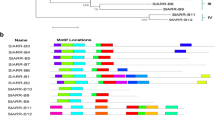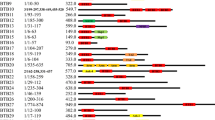Abstract
BRASSINAZOLE-RESISTANT (BZR) genes are a family that has transcription factors that are particular to plants and are involved in the signal transduction of brassinosteroids. This study identified nine BZR genes in tomato using a computational approach. BZRs are hydrophilic proteins mostly located in the nucleus. The most common secondary structure of BZRs is random coil. The number of introns contained in the BZR family genes is between 1 and 9, and these genes are distributed in a disarrayed fashion across the chromosomes, while there were two pairs of duplicated gene fragments. Forty-four cis-elements were identified in the region of the gene promoter, all of which were associated with plant hormones, tissue specific expression, response to stress, and light response. The genes in this family mainly responded to plant hormones such as gibberellin, salicylic acid, abscisic acid, auxin, and methyl jasmonate (MeJa). Analysis of the expression profile demonstrated that SlBZR gene expression was significantly different in tissues and organs at different developmental stages of tomato, and some genes had tissue specific expression. The results of qRT-PCR demonstrated that all genes in the BZR family were involved in stress response (200 mmol/L SA, 200 mmol/L ABA, and 4 °C). The results lay the foundation to further study the functions of tomato BZR genes.




Similar content being viewed by others
Abbreviations
- ABA:
-
Abscisic acid
- BES1:
-
Bri1ems-suppressor 1
- BRs:
-
Brassinosteroids
- BZR:
-
Brassinazole-resistant
- FPKM:
-
Fragments per kilobase of transcript per million mapped reads
- GA:
-
Gibberellin
- LTR:
-
Low temperature response element
- MBS:
-
MYB binding site
- MeJA:
-
Methyl jasmonate
- SA:
-
Salicylic acid
- TF:
-
Transcription factor
References
Alessandro M, Sara T, Silvia Q (2018) Identification and characterization of the BZR transcription factor family and its expression in response to abiotic stresses in Zea mays L. Plant Growth Regul 84:423–436
Bai XF, Huang Y, Hu Y (2018) Duplication of an upstream silencer of FZP increases grain yield in rice. Nat Plant 3(11):885–893
Bailey TL, Boden M, Buske FA (2009) MEME SUITE: tools for motif discovery and searching. Nucl Acids Res 37:W202–W208
Blanc G, Wolfe KH (2004) Widespread paleopolyploidy in model plant species inferred from age distributions of duplicate genes. Plant Cell 16(7):1667–1678
Campos ML, de Almeida M, Rossi ML (2009) Brassinosteroids interact negatively with jasmonates in the formation of antiherbivory traits in tomato. J Exp Bot 60(15):4347–4361
Clouse SD, Langford M, Mcmorris TC (1996) A brassinosteroid insensitive mutant in Arabidopsis thaliana exhibits multiple defects in growth and development. Plant Physiol 111(3):671–678
Clouse SD, Sasse JM (1998) Brassinosteroids: essential regulators of plant growth and development. Annu Rev Plant Physiol Plant Mol Biol 49:427–451
Clouse SD (2011) Brassinosteroid signal transduction: from receptor kinase activation to transcriptional networks regulating plant development. Plant Cell 23(4):1219–1230
Chen C, Xia R, Chen H, He Y (2018) TBtools, a Toolkit for Biologists integrating various HTS-data handling tools with a user-friendly interface. bioRxiv 2018:289660
Chen WY, Lv MH, Wang YZ (2019) BES1 is activated by EMS1-TPD1-SERK1/2-mediated signaling to control tapetum development in Arabidopsis thaliana. Nat Commun 10:4164
Derevyanchuk M, Litvinovskaya MR, Khripach V (2016) Brassinosteroid-induced de novo protein synthesis in Zea mays under salinity and bioinformatic approach for identification of heat shock proteins. Plant Growth Regul 78:297–305
Ding A, Marowa P, Kong Y (2016) Genome-wide identification of the expansion gene family in tobacco (Nicotiana tabacum). Mol Genet Genom 291(5):1891–1907
Dong X, Im SB, Lim YP (2014) Comparative transcriptome profiling of freezing stress responsiveness in two contrasting Chinese cabbage genotypes, Chiifu and Kenshin. Genes Genom 36(2):215–227
Galstyan A, Nemhauser JL (2019) Auxin promotion of seedling growth via ARF5 is dependent on the brassinosteroid-regulated transcription factors BES1 and BEH4. Plant Direct 3:e00166
He JX, Gendron JM, Sun Y (2005) BZR1 is a transcriptional repressor with dual roles in brassinosteroid homeostasis and growth responses. Science 307(5715):1634–1638
Hanada K, Zou C, Lehti-Shiu MD (2008) Importance of lineage-specific expansion of plant tandem duplicates in the adaptive response to environmental stimuli. Plant Physiol 148(2):993–1003
Hayat S, Irfan M, Ahmad A (2011) Brassinosteroids: under biotic stress. In: Brassinosteroids: a class of plant hormone, Netherlands: Springer Netherlands 345–360
Jiang J, Zhang C, Wang X (2015) A recently evolved isoform of the transcription factor BES1 promotes brassinosteroid. Cell 27(2):361–374
Kong WL, An BG, Zhang Y (2019) Sugar transporter proteins (STPs) in gramineae crops: comparative analysis, phylogeny, evolution, and expression profiling. Cells 8(6):560
Li H, Ye K, Shi Y, Cheng J, Zhang X, Yang S (2017) BZR1 positively regulates freezing tolerance via CBF-dependent and CBF-independent pathways in Arabidopsis. Mol Plant 10(4):545–559
Li J, Nam KH (2002) Regulation of brassinosteroid signaling by a GSK3/SHAGGY-like kinase. Science 295:1299–1301
Li J, Chory J (1997) A putative leucine-rich repeat receptor kinase involved in brassinosteroid signal transduction. Cell 90(5):929–938
Li YY, He LL, Li J (2018) BZR genome-wide identification, characterization, and expression profiling of the legume transcription factor gene family. Front Plant Sci 9:1332
Lv B, Tian H, Zhang F (2018) Brassinosteroids regulate root growth by controlling reactive oxygen species homeostasis and dual effect on ethylene synthesis in Arabidopsis. PLoS Genet 14(1):e1007144
Lynch M, Conery JS (2003) The evolutionary demography of duplicate genes. J Struct Funct Genom 3:35–44
Lynch M, Conery JS (2000) The evolutionary fate and consequences of duplicate genes. Science 290:1151–1155
Nolan TM, Brennan B, Yang M, Chen J, Zhang M, Li Z, Wang X, Bassham DC, Walley J, Yin Y (2017) Selective autophagy of BES1 mediated by DSK2 balances plant growth and survival. Dev Cell 41(1):33–46
Oh E, Zhu JY, Wang ZY (2012) Interaction between BZR1 and PIF4 integrates brassinosteroid and environmental responses. Nat Cell Biol 14(8):802–809
Oh E, Zhu JY, Ryu H (2016) TOPLESS mediates brassinosteroid-induced transcriptional repression through interaction with BZR1. Nat Commun 5:1–12
Panchy N, Lehti-Shiu M, Shiu SH (2016) Evolution of gene duplication in plants. Plant Physiol 171(4):2294–2316
Park CH, Seo C, Park Y (2020) Arabidopsis thaliana BES1 directly binds to the promoter of the ACC oxidase 1 gene to regulate gravitropic response in the roots. Plant Signal Behav 15:1690724
Ryu H, Kim K, Cho H (2007) Nucleocytoplas mic shuttling of BZR1 mediated by phosphorylation is essential in Arabidopsis brassinosteroid signaling. Plant Cell 19:2749–2762
Sahni S, Prasad BD, Liu Q (2016) Overexpression of the brassinosteroid biosynthetic gene DWF4 in Brassica napus simultaneously increases seed yield and stress tolerance. Sci Rep 6:28298
Singh AP, Savaldi-Goldstein S (2015) Growth control: brassinosteroid activity gets context. J Exp Bot 66:1123–1132
Soyk S, Simkova K, Zurcher E (2014) The enzyme-like domain of Arabidopsis nuclear beta-amylases is critical for DNA sequence recognitionn and transcriptional activation. Plant Cell 26:1746–1763
Saini S, Sharma I, Pati PK (2015) Versatile roles of brassinosteroid in plants in the context of its homoeostasis, signaling and crosstalks. Front Plant Sci 6:950
Song XY, Zhang YY, Wu FC (2016) Genome-wide analysis of the maize (Zea may L.) CPP-like gene family and expression profiling under abiotic stress. Genet Mol Res 15(3):15038023
Suyama M, Torrents D, Bork P (2006) PAL2NAL: robust conversion of protein sequence alignments into the corresponding codon alignments. Nucl Acids Res 34:W609–W612
Sun Yu, Xiying F, Dongmei C (2010) Integration of brassi-nosteroid signal transduction with the transcription network for plant growth regulation in Arabidopsis. Dev Cell 19(5):765–777
Tong H, Chu C (2012) Brassinosteroid signaling and application in rice. J Genet Genom 39:3–9
Vardhini BV, Anjum NA (2015) Brassinosteroids make plant life easier under abiotic stresses mainly by modulating major components of antioxidant defense system. Front Environ Sci 2:67
Wang ZY, Nakano T, Gendron J (2002) Nuclear-localized BZR1 mediates brassinosteroid-induced growth and feedback suppression of brassinosteroid biosynthesis. Dev Cell 2:505–513
Wu P, Song XM, Wang Z (2016) Genome-wide analysis of the BES1 transcription factor family in Chinese cabbage. Plant Growth Regul 80:291–301
Yu HQ, Sun FA, Feng WQ (2019) The BES1/BZR1 transcription factors regulate growth, development and stress resistance in plants. Yi Chuan 41:206–214
Yu X, Li L, Zola J (2011) A brassinosteroid transcriptional network revealed by genome-wide identification of BESI target genes in Arabidopsis thaliana. Plant J 65:634–646
Ye QQ, Zhu WJ, Li L (2010) Brassinosteroids control male fertility by regulating the expression of key genes involved in Arabidopsis anther and pollen development. Proc Natl Acad Sci USA 107(13):6100–6105
Yin Y, Vafeados D, Tao Y (2005) A new class of transcription factors mediates brassinosteroid regulated gene expression in Arabidopsis. Cell 120:249–259
Yin Y, Wang ZY, Mora-Garcia S (2002) BES1 accumulates in the nucleus in response to brassinosteroids to regulate gene expression and promote stem elongation. Cell 109:181–191
Zhu JY, Sae-Seaw J, Wang ZY (2013) Brassinosteroid signalling. Development 140:1615–1620
Zhu XL, Wei WBQ, Wang XH (2021) Genome-wide identification, characterization and expression analysis of the LIM transcription factor family in quinoa. Physiol Mol Biol Plants 27(4):787–800
Funding
This work was supported by National Natural Science Foundation of China (32060401).
Author information
Authors and Affiliations
Contributions
Xiaohong Wei conceived and designed the research. Xiaolin Zhu conducted experiments and prepared seed materials. Baoqiang Wang wrote the manuscript. All authors read and approved the manuscript for publication.
Corresponding author
Ethics declarations
Conflict of interest
The authors declare that they have no competing interests.
Human and animal participants
This article does not contain any studies with human participants or animals performed by any of the authors.
Additional information
Publisher's Note
Springer Nature remains neutral with regard to jurisdictional claims in published maps and institutional affiliations.
Supplementary Information
Below is the link to the electronic supplementary material.
Rights and permissions
About this article
Cite this article
Wang, B., Zhu, X. & Wei, X. Genome-wide identification, structural analysis, and expression profiles of the BZR gene family in tomato. J. Plant Biochem. Biotechnol. 31, 739–750 (2022). https://doi.org/10.1007/s13562-021-00711-y
Received:
Accepted:
Published:
Issue Date:
DOI: https://doi.org/10.1007/s13562-021-00711-y




